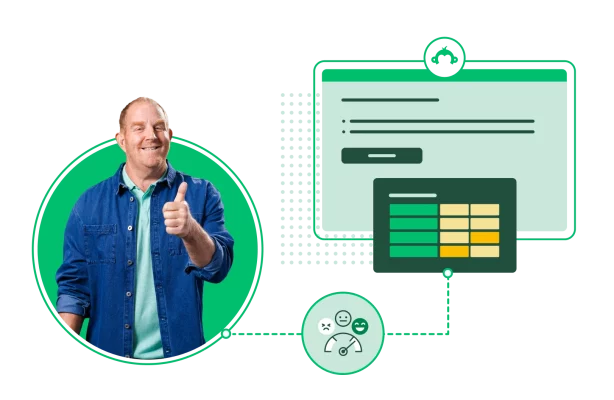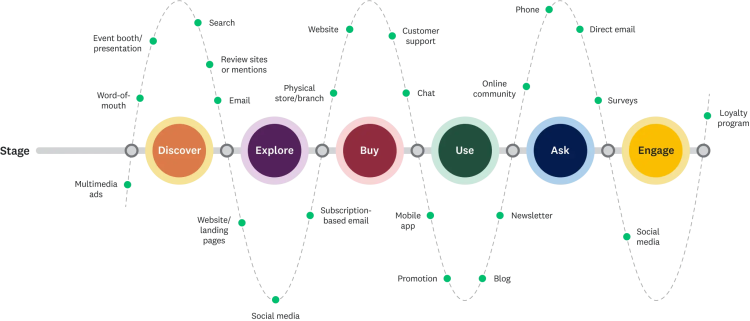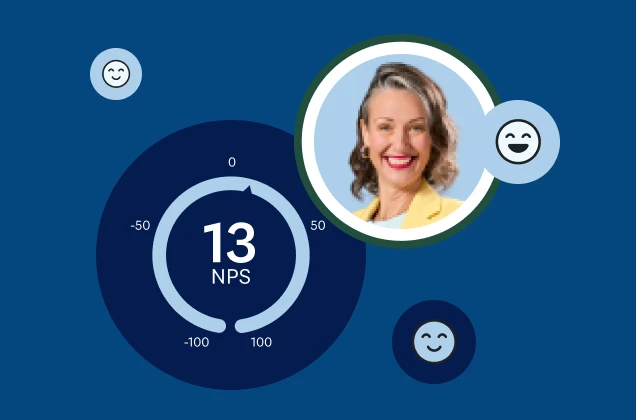The ultimate guide to understanding, creating, and improving the customer journey

If you want to improve sales and build your brand, you should think less like an entrepreneur—and more like a customer. Why? You could have great products, an excellent website, speedy delivery, and a dedicated customer service team. Still, any problem in your customer journey could send potential customers elsewhere.
How do you improve this process? Thinking like a customer and plotting the customer journey can help you trace customer touchpoints from the first contact to post-purchase engagements. Identifying and improving customer touchpoints will enhance the customer experience (CX) and lead to a satisfied, loyal customer base.
Learn about customer journeys in our ultimate guide. Find out what they are, how to identify your customer journey, and map it for increased sales.
What is a customer journey?
A customer journey is the sequence of interactions a buyer has with your brand over the customer lifecycle. The customer journey extends from the first touchpoint a customer has with your brand to the retention phase.
Gaining insight into the customer journey your audience takes enables you to optimize it, ensuring a satisfactory customer experience. Considering that 89% of CX pros believe that the customer experience is the leading contributor to churn, improving it should be your highest priority.
Although we think of the customer journey as a single concept, it consists of nine distinct stages.
Customer journey stages
A new customer may feel differently about your brand than a long-time customer. Knowing each step of the customer journey helps your business communicate with customers at each stage.
Let's look at each step of the customer journey and how customers interact with your company at that point.
Awareness
The first stage of the customer journey is awareness. At the awareness stage, a customer comes across your brand for the first time. Customers may not know a lot about your company, but they want to learn more about what you offer.
There are several potential ways that a customer could have come across your brand:
- Scrolling and seeing a social media post
- Clicking on a blog post from a Google search
- Reading company research you have published
- Seeing an advertisement for one of your products
Consideration
The second stage of the customer journey is consideration. At the consideration stage, the customer has engaged with your content and may have read through your offerings. Typically, they want to see how you stand out from competitors and whether your products and services are unique.
The consideration stage defines customers as:
- Curious about your products
- Interested in learning more
- Inspired to do more research after receiving a recommendation from a friend or after seeing another advertisement
Interest
The third stage of the customer journey is interest. At the interest stage, potential customers engage in thorough research. Potential customers may read through your product descriptions and participate in product demos.
Customers in the interest stage will:
- Engage thoroughly with your products
- Request more information about the services you offer
- Read through reviews of your services and products
Intent
The fourth stage of the customer journey is intent. At the intent stage, your customer decides that they want to try out your products and services. They will identify a potential pain point you can solve and prepare to purchase.
Customers in the intent stage of the customer journey may:
- Request a sales demo
- Reach out to a sales representative
- Request a quote
- Add a product to their cart
Purchase
The fifth stage of the customer journey is purchase. At the purchase stage, your customer commits to doing business with your company. Purchase is the first transactional touchpoint, converting a lead into a paying customer.
This stage of the customer journey is the product of all of the earlier research. Customers in this stage will:
- Purchase from your website
- Go into a local store to purchase a product
- Buy or engage in a trial of a service
Post-Purchase
The sixth stage of the customer journey is post-purchase. In the post-purchase phase, your customers will use and interact with your products and services for the first time. They’ll likely assess the quality of your offerings and see if they meet expectations.
Your company may engage with the customer in the following ways during the post-purchase phase:
- Offering guidance or tutorials on how to use a product or service
- Supporting the customer with customer service teams if they need help
- Sending out customer surveys to monitor their satisfaction with your offerings
Retention
The seventh stage of the customer journey is retention. At the retention phase, your business will focus on strengthening its relationship with a customer. You’ll aim to foster loyalty and increase their satisfaction with your brand.
At this stage, customers typically:
- Have made at least one or many purchases with your business
- May engage with a customer loyalty scheme or points system
- Will receive personalized offers and deals from your business
Advocacy
The eighth stage of the customer journey is advocacy. At the advocacy stage, your customers are seasoned buyers of your business. They enjoy your products and have high satisfaction rates, prompting them to actively promote your business to their friends and colleagues.
Customers who are in the advocacy stage of the customer journey will:
- Leave online reviews of your products
- Endorse your products through social media posts
- Recommend your products and services to friends, family, and colleagues
Loyalty
The ninth and final stage of the customer journey is loyalty. This ongoing stage of the customer journey is for your most satisfied customers. At this point, your customers are very happy with your products and services and have decided to stick with your business.
Customers in this final stage of the customer journey will:
- Love your products and services and will recommend them to everyone they know
- Repeatedly buy your products, often for periods extending over several years
- Extensively engage with available loyalty programs
- Receive highly personalized marketing materials, offers, and gifts from your business
What is customer journey mapping?
Customer journey mapping is a visual representation of customer touchpoints. Here is an example:

Customer touchpoints are any moment when a customer comes into contact with your brand. These can extend from initial contact, like seeing an ad, to engaging with your loyalty program after being a devout customer.
Identifying the most critical customer touchpoints across your journey map can help you optimize each point. Better customer touchpoints will provide a seamless experience that enhances customer satisfaction.
Customer journey mapping benefits
Customer journey mapping gives you full visibility of your customer journey. There are numerous benefits to customer journey mapping.
- Decrease customer touchpoint friction: Customers who have bad experiences with certain touchpoints may avoid interacting with your business. Mapping out customer touchpoints and monitoring them can help you improve any potential setbacks in the customer journey.
- Improve retention: By improving your late-stage customer touchpoints as needed, your customers will experience higher satisfaction rates. This approach will improve retention and decrease churn.
- Enhance CX: The customer experience defines how customers interact with your brand. Mapping your customer journey allows you to improve every single one of these interactions and consistently satisfy your customers.
- Drive sales: Customers who feel happier with your brand are more likely to return to buy again. Improving the customer touchpoints can improve sales and drive revenue.
- Increase customer loyalty: When you exceed the needs of your customers, they’ll feel a greater sense of loyalty to you.
Creating a customer journey map allows your business to better understand every interaction with your customers. Monitoring each touchpoint with customer satisfaction metrics will help you improve your customer experience and satisfy your customers.
How to map your customer journey: Step-by-step guide

Mapping your customer journey allows you to enhance and streamline every interaction a customer has with your business. Companies that improve the customer journey can offer customers a winning CX, boosting satisfaction and loyalty.
Here’s how to map your customer journey, covering every important step you should know.
Set your customer journey map objectives
Objectives are critical to customer journey mapping. After all, how can you map the journey if you aren’t sure of the destination?
Depending on the objective of your customer journey map, the structure and strategies you use will vary. Let’s explore a few different potential objectives.
- Improve customer retention: This objective would suggest that your main goal is to identify customer pain points in the customer journey and mitigate them over time.
- Boost conversion rates: If you want to improve sales, your customer journey map will focus on data-driven strategies to enhance conversion and improve the consideration and interest stages.
- Enhance your products: If you want to enhance your current offerings, your customer journey map may include creating post-purchase or product feedback surveys and improving data collection.
If you’re unsure where to begin, we suggest looking at your customers. Collecting customer data via surveys or conducting market research will help identify potential areas for improvement.
Once you’ve made a list of CX priorities and objectives, it’s time for the next step.
Create customer personas
Customer personas involve creating detailed customer profiles that represent subsections of your target audience. Each customer persona may have different pain points or characteristics that make them stand out.
You can create a more comprehensive plan by adapting your customer journey map to each of these segments. Here is a step-by-step guide to creating customer personas.
- Gather customer data: You can collect customer data by using surveys. Ask questions about demographics, satisfaction, and customer experiences with your product and services.
- Collate and analyze: Gather your data then conduct statistical analysis to identify trends, patterns, and important themes across your customer data.
- Segment the data: You can find trends among different customer groups based on demographic information.
- Craft personas: Create customer profiles based on demographic data. Include challenges, motivations, communication preferences, and goals for each group.
- Verify groups: Before launching these customer profiles, be sure to double-check them against your internal data. You can update your customer personas by using data from customers or focus groups to better match your business.
Surveys are a great way to gather information about different parts of the customer experience that you want to study. They provide insight into everything from customer satisfaction to loyalty.
Using surveys will give you the foundation of data to create effective customer personas.
Identify your customer touchpoints
The best way to identify customer touchpoints is to think like a customer. Imagine the process they would likely go through from their first interaction with your brand.
Let’s chart some of the most common customer touchpoints across the customer journey map.
- Before the transaction: This could be one of your marketing efforts, like ads, online testimonials, or social media activity. Customers can also form an impression through product reviews on e-commerce sites or word of mouth.
- During the transaction: Your point of sale environment could be a physical store, a website, or a catalog. Customers might interact with your staff, sales team, or call center at these touchpoints.
- After the transaction: These touchpoints involve billing, product support, questions, and returns. You might send customer feedback surveys, product newsletters, or thank you cards.
After mapping out the touchpoints in the customer journey, trace how they all fit together. Are there any obstacles the customer might experience along the way? Are any of the touchpoints missing or underserved?
Creating a Voice of the Customer (VOC) program helps you understand the customer experience at all touchpoints. Gathering customer feedback with Net Promoter Score® (NPS), Customer Satisfaction (CSAT), and Customer Effort Score (CES) surveys will give you the insight you need to refine your CX.
Customer journey mapping best practices
Customer journey mapping can become complex, especially for scaling businesses or enterprises. Here are our best practices for creating a customer journey map effectively.
Leverage customer journey mapping templates
Every company will offer a different customer journey. That said, every map will typically pass through similar phases. With that in mind, leveraging a template can help you reduce the time it takes to create a customer journey map.
Start by writing down each of the stages of the customer journey. Next, you can fill in the common touchpoints for each phase. Finally, adding additional context can personalize this template to your business.
A customer journey map template makes it easier to track the customer journey process faster and more efficiently.
Use surveys to map customer touchpoints
There are a lot of potential customer touchpoints. Some businesses may have 100s, while others may have 1000s. Surveys are the best method of collecting data across all of these customer touchpoints.
Surveys are effective as they:
- Are quick to develop (especially when using a customer satisfaction survey template)
- Quickly gather both quantitative and qualitative data
- Are flexible, allowing you to personalize questions
Surveys provide a much-needed layer of logic and data. Using surveys at each major customer touchpoint will enable you to identify issues and efficiently remedy them.
Gather feedback at every touchpoint

Gathering feedback at every touchpoint gives your business a comprehensive customer journey overview. Automating your surveys is an effective way of capturing information at each touchpoint.
You can trigger a touchpoint survey whenever a customer interacts with an important touchpoint. For example, an interaction with customer support can trigger a customer support satisfaction survey that helps you understand if the team was helpful.
The more feedback your business has, the more context it will have to act upon and improve the customer experience.
Put the customer’s needs first with your customer journey map
Your business might have a superior product, dynamic shopping cart, or top-notch customer support team. However, they won’t amount to much if your customers have trouble accessing them. Resolving friction in the customer journey will improve customer satisfaction and customer loyalty.
Want to enhance your customer journey experience? Try using SurveyMonkey customer experience management software to scale your efforts and get feedback everywhere you need.
Net Promoter, Net Promoter Score, and NPS are trademarks of Satmetrix Systems, Inc., Bain & Company, Inc., and Fred Reichheld.
Discover more resources

Customer satisfaction survey templates
Explore our customer satisfaction survey templates to rapidly collect data, identify pain points, and improve your customer experience.

See why Together Labs relies on SurveyMonkey for user insights
Discover why Together Labs ditched Google Forms and upgraded to SurveyMonkey Enterprise to collect in-depth user feedback.

Learn how Point of Reference gets the most out of NPS surveys
Discover how Point of Reference uses SurveyMonkey to capture valuable customer feedback, including Net Promoter Score (NPS®).

Ecommerce Payment Form Template
Streamline your online transactions with our Ecommerce Payment Form Template. Secure, easy to use, and customizable to fit your business needs.